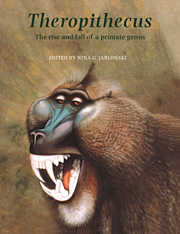Book contents
- Frontmatter
- Contents
- List of Contributors
- Preface
- Acknowledgements
- 1 Introduction
- PART I Fossil evidence and phylogeny
- PART II Biogeography and evolutionary biology
- PART III Anatomy of the fossil and living species of Theropithecus
- 10 Allometric aspects of skull morphology in Theropithecus
- 11 Evolution of the masticatory apparatus in Theropithecus
- 12 Dental microwear and diet in extant and extinct Theropithecus: preliminary analyses
- 13 The development and microstructure of the dentition of Theropithecus
- 14 Postcranial anatomy of extant and extinct species of Theropithecus
- PART IV Behaviour and ecology of living and fossil species of Theropithecus
- Appendix I A partial catalogue of fossil remains of Theropithecus
- Appendix II Conservation status of the gelada
- Index
11 - Evolution of the masticatory apparatus in Theropithecus
Published online by Cambridge University Press: 11 November 2009
- Frontmatter
- Contents
- List of Contributors
- Preface
- Acknowledgements
- 1 Introduction
- PART I Fossil evidence and phylogeny
- PART II Biogeography and evolutionary biology
- PART III Anatomy of the fossil and living species of Theropithecus
- 10 Allometric aspects of skull morphology in Theropithecus
- 11 Evolution of the masticatory apparatus in Theropithecus
- 12 Dental microwear and diet in extant and extinct Theropithecus: preliminary analyses
- 13 The development and microstructure of the dentition of Theropithecus
- 14 Postcranial anatomy of extant and extinct species of Theropithecus
- PART IV Behaviour and ecology of living and fossil species of Theropithecus
- Appendix I A partial catalogue of fossil remains of Theropithecus
- Appendix II Conservation status of the gelada
- Index
Summary
Summary
The nature of the adaptation of the earliest theropiths is not known, but there is now considerable evidence to support the hypothesis that the emergence and early diversification of Theropithecus was linked to the evolution of a feeding apparatus specialized for the eating of grasses. This made possible the invasion of grassland environments previously not colonized by primates. Specializations for grazing in Theropithecus included those of the hand – important for the harvesting of grass parts – and those of the masticatory apparatus.
In this study, simple scaling and biomechanical analyses are used to describe the functional changes of the masticatory apparatus that accompanied structural changes in the skull and teeth of Plio-Pleistocene and later Pleistocene species of Theropithecus.
In T. brumpti and its putative forebears T. baringensis and T. quadratirostris, evolution of longer muzzles was correlated with the anterior and lateral expansion of the origin of the masseter muscle. The masticatory apparatus of T. brumpti was designed to meet the requirements of a large gape during feeding as well as during canine displays. The muscles of mastication in this species, in particular the masseter and the temporalis, were very large. It is suggested that these muscles were mostly fleshy, with relatively long parallel fibres and long sarcomeres, as opposed to being multipennate in structure. Such an arrangement would have permitted the muscles to be stretched during the wide jaw opening (gape) necessary for canine displays yet – because of the large cross-sectional areas of the muscles – capable of generating high occlusal pressures between the molar teeth even when the jaws were widely separated.
[…]
- Type
- Chapter
- Information
- TheropithecusThe Rise and Fall of a Primate Genus, pp. 299 - 330Publisher: Cambridge University PressPrint publication year: 1993
- 19
- Cited by



